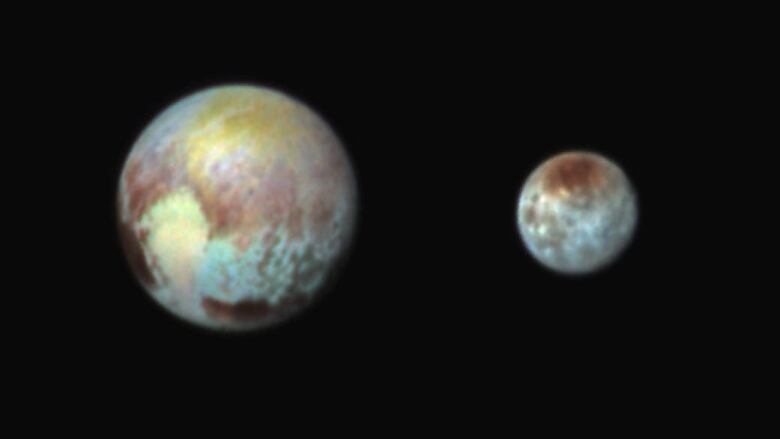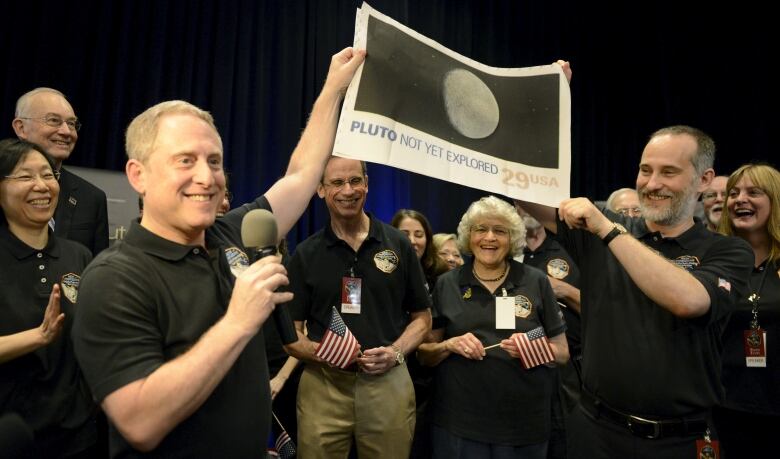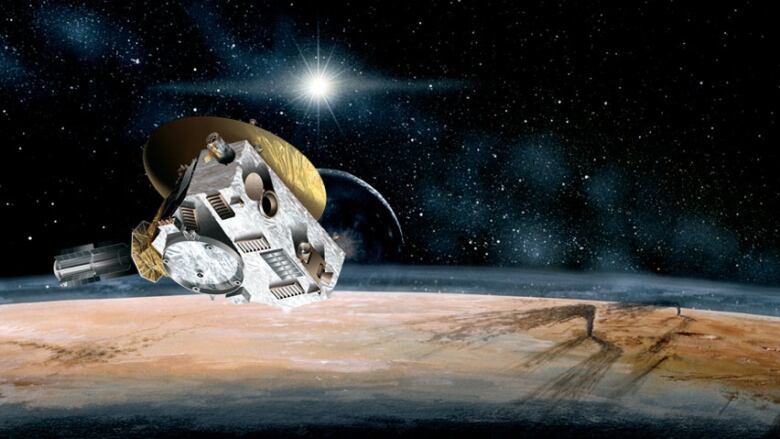Pluto flyby confirmed by NASA
Even better images of Pluto expected to start 'raining' down to Earth on Wednesday

LOCKED! We have confirmation of a successful #PlutoFlyby. pic.twitter.com/Krfo9qxxHw
—@NASANewHorizonsNASA confirmed Tuesday night that its New Horizons spacecraft successfully completed a flyby of Pluto, culminating an epic journey from Earth that took 9years and spanned more than 4.8 billion kilometres.
The confirmation, which came inat 8:52 p.m. ET, was met by cheers from the New Horizons team in thecontrol room in Laurel, Md.
"Just like we planned it, just like we practised," said Alice Bowman, the mission's operations manager for the project. "We did it, it's just great."
- New Horizons' data dump from Pluto will be 'gift for the ages'
- QUIZ|10 questions about the mighty dwarf planet Pluto
- 6 facts you should know about Pluto
- NeildeGrasseTyson denies he's a 'Pluto hater' on Twitter
Early indications had been encouraging, and aflag-waving celebration swept over the mission operations centre in Maryland at the time of closest approach Tuesday morning. But until New Horizons phoned home Tuesday night, there was no guarantee the spacecraft had buzzed the small, icy, faraway but no longer unknown world.
The 13-hour wait for confirmation of the flyby was necessary because NASA had kept New Horizons busy taking pictures of Pluto, its jumbo moon Charon and its four little moons during thecritical period, rather than communicating to Earth.

This is the last stop on a planetary tour of the solar system a half-century in the making.
"This is truly a hallmark in human history," said John Grunsfeld, NASA's science mission chief. "It's been an incredible voyage."
According to NASA, the spacecraft the size of a baby grand piano swept to within 12,400 kilometresof Pluto at 50,000 km/h. It was programmed to go past the dwarf planet and begin studying its far side.
Even better images will start "raining" down on Earth beginning Wednesday, promised principal scientist Alan Stern.
The spacecraft senta briefengineering report back Tuesday night.
"We wanted that report to be as brief as possible, because as soon as that was over, New Horizons went back to work collecting that data," Stern said.
The spacecraft is expected to send images at "10 times" the resolution ofthe new images of Pluto released earlier Tuesday. It is also expected to send data about Pluto's atmosphere, colours and moons.
Cosmic coincidence
In a cosmic coincidence, the encounter occurred 50 years after Mariner 4's flyby of Mars that yielded the first close-up pictures of the Red Planet.
"I think it's fitting that on the 50th anniversary we complete the initial reconnaissance of the planets with the exploration of Pluto," saidStern.

Inside "countdown central" Tuesday morning, hundreds jammed together to share in the final minutes, including the two children of the late American astronomer who discovered Pluto in 1930, Clyde Tombaugh.
Tombaugh's ashes are aboard the spacecraft and will be the first to leave the solar system.
- NASA's New Horizons navigator Frdric Pelletier guides Pluto probe
- Physicist Tim Blais pays musical tribute to New Horizons, Pluto
The crowd waved U.S. flags and counted down the seconds, screaming, cheering and applauding. Chants of "U.S.A.!" broke out.

The United States is now the only nation to visit every single planet in the solar system. Pluto was No. 9 in the lineup when New Horizons departed Cape Canaveral, Florida, in 2006 to shed light on the mysterious icy world, but was demoted seven months later to dwarf status. Scientists in charge of the $720-million US mission, as well as NASA officials, hope the new observations will restore Pluto's honour.
Success had not been guaranteed
At a news conference after the morning celebration, Grunsfeld, Stern and Bowman unveiled a picture of Pluto taken just Monday. The icy, impacted world a fusion of peach and brassy colours with bright spots at points northward, including the now-famous heart, and darker areas around the equator drew oohs and aahs.
NASA's planetary science director, Jim Green, had been "on pins and needles." During its approach to Pluto, New Horizons scouted for any dangerous debris out there that could wipe out the mission.The odds of a devastating blowwere said to be an extremely low one or two in 10,000.
It takes 4hours for signals to travel one-way between New Horizons and flight controllers, the speed of light. The last time controllers heard from the spacecraft was Monday night, according to plan.
'Mind-boggling' images
New Horizons already has beamed back the best-ever images of Pluto and big moon Charon. Pluto's other smaller moons are alsoexpected to come under New Horizons' scrutiny.
The pictures are "mind-boggling to put it mildly," NASA administrator Charles Bolden said.

The fulldatasetwill takeabout 16months, and is expected to be complete in October or November 2016.
Little known about Pluto
Up to now, little has been known about Pluto, the most distant planetary body in the solar system and the last to be explored by NASA.
On the eve of the flyby, NASA announced that Pluto is actually bigger than anyone imagined, thanks to measurements made by the spacecraft. It's about 80 kilometreswiderthan estimated, for a grand total of 2,370 kilometresin diameter.
Pluto was downgraded from a planet to a dwarf planet in 2006 and is thought to contain important clues about the origins of the solar system.
With files from Reuters and CBC News












_(720p).jpg)


 OFFICIAL HD MUSIC VIDEO.jpg)
.jpg)



























































































